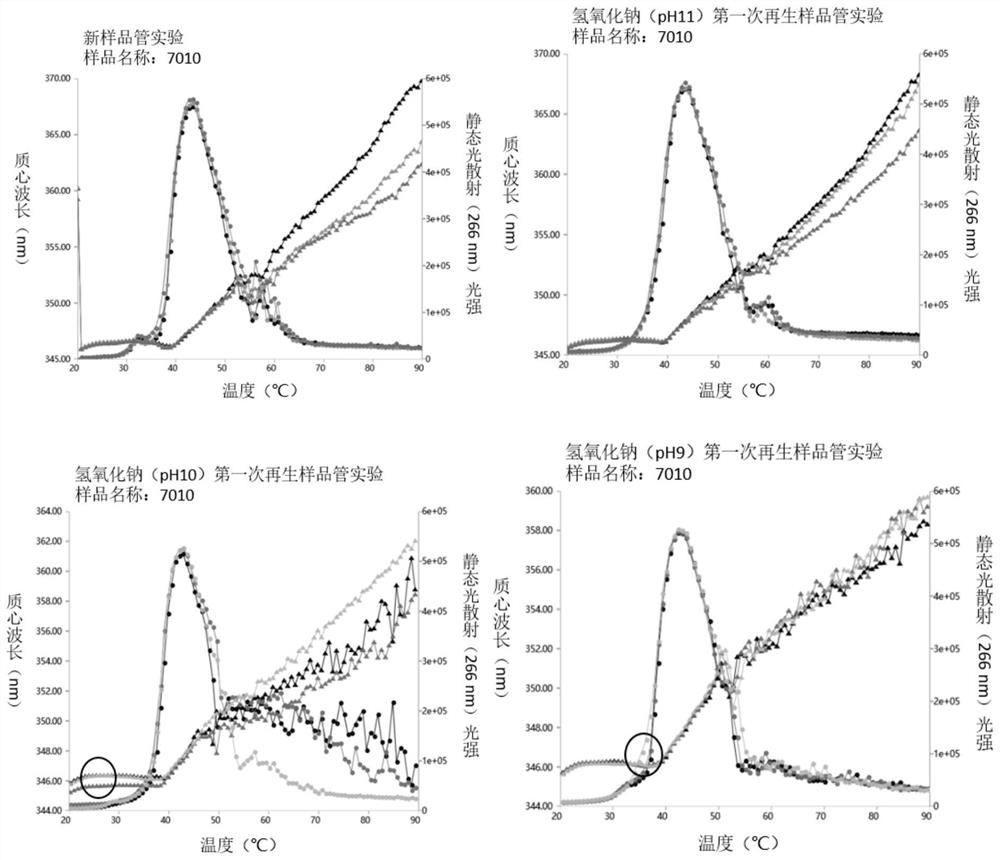Regeneration method of sample tube for multi-parameter protein stability analyzer
A technology of stability analyzer and sample tube, which is used in cleaning methods, chemical instruments and methods, cleaning methods and utensils using liquids, etc., can solve the problems of high cost, reuse, and inability to wash, and achieves excellent regeneration effect. The effect of avoiding corrosion
- Summary
- Abstract
- Description
- Claims
- Application Information
AI Technical Summary
Problems solved by technology
Method used
Image
Examples
Embodiment 1
[0035] A method for regenerating sample tubes using sodium hydroxide solutions of different pH values, comprising the following steps:
[0036] Step 1. After the protein stability experiment is over, rinse the protein solutions in the three sample tubes with ultrapure water, and place them in three sodium hydroxide solution regeneration agents with pH values of 11.0, 10.0, and 9.0 respectively. 30 minutes.
[0037] Step 2. Place the sample tube soaked in the regenerant in an ultrasonic instrument, and use ultrapure water to sonicate for 60 seconds.
[0038] Step 3. Rinse the ultrasonically treated sample tube with ultrapure water to rinse the remaining regenerant.
[0039] Step 4. Finally, use compressed air to blow dry, and the first regeneration experiment of the sample tube is over.
[0040] Step 5, compare the Tm values of different water-soluble protein solutions before and after sample tube regeneration, the coefficient of variation CV% calculated by formula 1, and...
Embodiment 2
[0054] A method for regenerating sample tubes using hydrochloric acid solutions of different pH values, comprising the following steps:
[0055] Step 1. After the protein stability test is over, rinse the protein solutions in the three sample tubes with ultrapure water, and place them in three hydrochloric acid solution regeneration agents with pH values of 3.0, 2.0, and 1.5 for 30 minutes. .
[0056] Step 2. Place the sample tube soaked in the regenerant in an ultrasonic instrument, and use ultrapure water to sonicate for 60 seconds.
[0057] Step 3. Rinse the ultrasonically treated sample tube with ultra-pure water to rinse the residual regenerant.
[0058] Step 4. Finally, use compressed air to blow dry, and the first regeneration experiment of the sample tube is over.
[0059] Step 5. Compare the Tm values of different water-soluble protein solutions before and after sample tube regeneration, the coefficient of variation CV% calculated by formula 1, and the coinciden...
Embodiment 3
[0073] The data result that step 9 obtains in embodiment 1 and 2 is as Figure 5 as shown, Figure 5 The sodium hydroxide solution regeneration sample tube with pH value 11.0 shown in 5 times obtains the variation coefficient CV% of four kinds of proteins to be 0.31%, 0.78%, 1.87%, 0.31% respectively; The hydrochloric acid solution regeneration sample tube 5 with pH value 3.0 The coefficients of variation of the four proteins obtained after the second time were 0.82%, 0.77%, 1.88%, and 0.57%, respectively. The Tm values of the four protein solutions obtained by regenerating the sample tubes five times are very close, and the coefficients of variation are all controlled within 10%, and the regeneration effect of the regenerant used is remarkable. Figure 6 The fluorescence signal curve and the static light scattering signal curve of the IgG protein solution were obtained after the sample tube was regenerated five times with the sodium hydroxide solution with a pH value of 11...
PUM
 Login to View More
Login to View More Abstract
Description
Claims
Application Information
 Login to View More
Login to View More - R&D
- Intellectual Property
- Life Sciences
- Materials
- Tech Scout
- Unparalleled Data Quality
- Higher Quality Content
- 60% Fewer Hallucinations
Browse by: Latest US Patents, China's latest patents, Technical Efficacy Thesaurus, Application Domain, Technology Topic, Popular Technical Reports.
© 2025 PatSnap. All rights reserved.Legal|Privacy policy|Modern Slavery Act Transparency Statement|Sitemap|About US| Contact US: help@patsnap.com



